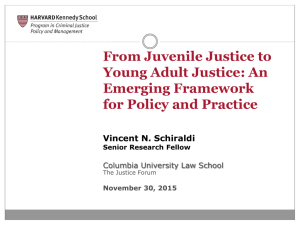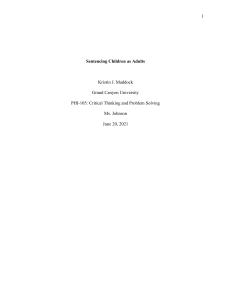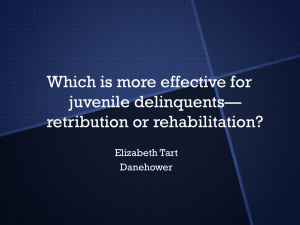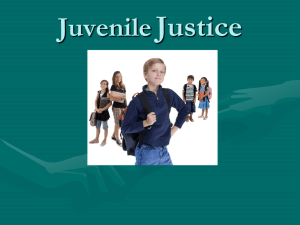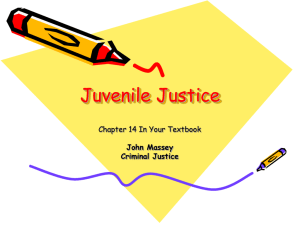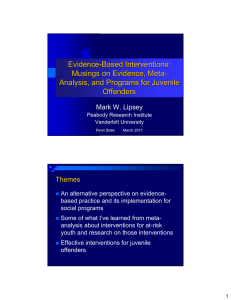Report on Study of Youthful Offenders Pursuant to Session Law
advertisement
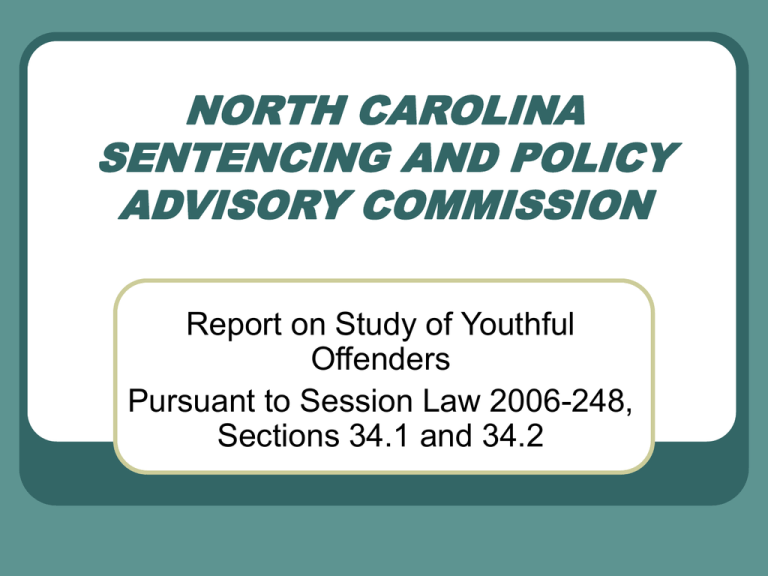
NORTH CAROLINA SENTENCING AND POLICY ADVISORY COMMISSION Report on Study of Youthful Offenders Pursuant to Session Law 2006-248, Sections 34.1 and 34.2 Commission Study Process Composition of the Sentencing Commission Study topics Submitted to the 2007 Session of the North Carolina General Assembly http://www.nccourts.org/Courts/CRS/Councils/spac/ Recommendations Increase the age of juvenile jurisdiction to persons who, at the time they commit a crime or infraction, are under the age of 18. (Traffic offenses committed by persons 16 and older will remain within the jurisdiction of the adult criminal courts.) Retain the current criteria and process for transfer of alleged juvenile offenders to Superior Court for trial as adults. Recommendations (cont’d) Delay the implementation of the change in juvenile jurisdiction by two years after passage of the bill and create a task force to analyze legal, systemic and organizational changes required; to determine necessary resources; and to produce a detailed road map for implementation of the new law. The Informational Basis for the Commission's Recommendations Legal review Developmental issues Offense profile of youthful offenders Public safety considerations Recidivism and other social costs Legal Review North Carolina laws and history (presentation by Prof. Janet Mason) Comparison of North Carolina with other states Developmental Issues Physiological, cognitive, and psychosocial factors (presentation by Dr. Cindy Cottle) Offense profile of youthful offenders (FY 2007/08) Age at Offense Offense Class of Conviction 16 to less than 18 years # % Class A-E Subtotal 311 2.8 Class F-I Subtotal 1,512 13.5 1,823 16.3 462 4.1 8,887 79.6 9,349 83.7 11,172 100.0 Felonies Felony Subtotal Misdemeanors Class A1 Class 1-3 Subtotal Misdemeanor Subtotal TOTAL Public safety considerations All juveniles 13 and older charged with any felony can be transferred to the criminal justice system at the discretion of the court Mandatory transfer to adult court for those aged 13 and older charged with first degree murder Most offenses committed by 16-17 year olds are misdemeanors and non-violent felonies Evidence from other states Recidivism and other social costs Research findings indicate that 16-17 year olds processed in adult court have higher recidivism rates and an increased rate of violence. Recidivism and other social costs are linked to permanent adult record of 16-17 year olds limiting their education, employment, military service, and other non-criminal opportunities. Which System – Juvenile or Adult – would be more appropriate to both serve the needs of 16-17 year olds and protect the public from their reoffending? The Criminal Justice and Juvenile Justice Systems have been described earlier by representatives of DOC and DJJDP. The Sentencing Commission’s recommendation points to the Juvenile Justice System as the more appropriate to serve juveniles 16-17 year olds. Advantages of the Juvenile Justice System for 16-17 year olds There are system responses for all cases – whether closed, diverted, dismissed or adjudicated. For cases referred to court, judge has extensive information from the juvenile court counselor, risk and needs assessment, etc. to make best decision. System has more certainty and control over cases referred to court, whether placed on probation (with lower caseloads and more hands-on supervision), sent to a detention center, or committed to a youth development center. Advantages of the Juvenile Justice System for 16-17 year olds (cont’d) Age group differences are taken into account in treatment and programming, with an eye for best practices that are age-specific. Expunction of juvenile records for misdemeanor and nonviolent felony adjudications allows for more non-criminal opportunities. What works for juveniles? Programming that is age specific to adolescents’ needs Programming that is effective in reducing delinquent and other anti-social behavior Programming that is cost effective (shortversus long-term costs/benefits) Conclusion o What works for juveniles also enhances public safety and thereby is, ultimately, cost effective.

